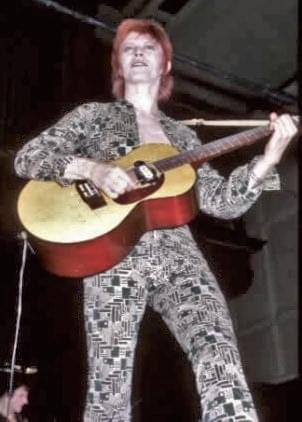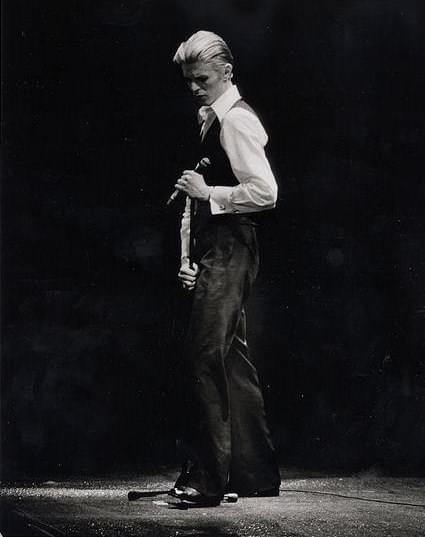Culture
One Life, Many Personas : David Bowie, Space Oddity (8 January 1947 – 10 January 2016)
Paddy Padmanabhan
Jan 12, 2016, 06:43 PM | Updated Feb 12, 2016, 05:28 PM IST
Save & read from anywhere!
Bookmark stories for easy access on any device or the Swarajya app.


We start 2016 with the departure of two of the hardest living rockers of the golden years of rock – Lemmy Kilmister, Motorhead and David Bowie, Space Oddity. Rebel, rebel.
Rock stars remain relevant in one of two ways: early death and relentless reinvention. David Bowie was the epitome of the latter, building and shedding persona after persona, musically and figuratively, over a 40 year career and releasing his final album Blackstar, a mere few days before passing away on 10 January.
How does one define Bowie’s music? Experimental, Eclectic, Electronic – these and other epithets would all fit nicely on his epitaph, yet they would not be enough. Born in London’s Brixton neighborhood in 1947, Bowie – born David Robert Jones, changing his name to avoid being confused with a Monkee named Davy Jones – came of age at a perfect time and place in the history of popular music, the late sixties in swinging London.
Recognized as a gifted child, David Bowie quickly came into the counterculture scene in London as an original and creative musician and performer. He wore the accoutrements of the job – looks, libido, lyricism – well. Success came early. Space Oddity, his first no. 1 single, came out in 1969, after which there was no looking back.
By his own admission, he was not a gifted musician per se. He was gifted with a degree of musical talent and a penchant for spotting pop culture trends which he parlayed into an enduring career in popular music. It’s worth looking at the arc of his career from this perspective.
David Bowie’s career has been broken down into various phases – the Ziggy Years, The Berlin Years, The Electronica Years, and so on. But these are just neat little compartments for academic interest. Like the chameleon he undoubtedly was, he fluidly transitioned from one phase to another, always remaining a step ahead of the next thing, sometimes to his own surprise.
Was it was odd that Space Oddity, a song about a fictional astronaut, became a hit just before we put a man on the moon? Was it strange that the elaborate persona he created around his album the Rise and fall of Ziggy Stardust, with elaborate, theatrical and often shocking stage performances in make-up and costume personifying the mythical Ziggy Stardust, presaged the glam-rock era that was coming into vogue, represented by artists such as Gary Glitter and Elton John in the U.K and Alice Cooper in the U.S?
Bowie was perhaps astute enough to realize that the music alone wouldn’t be enough to get him noticed. After all, this was the time bands like Led Zeppelin, The Stones and the Who were at the pinnacle of their creativity, and it would take something quite different to be noticed in the crowd.

With the surprising success of the song Fame, co-written with John Lennon, in the U.S charts, Bowie moved to New York and fell in with the alt-rock/punk movement which was coming of age in the CBGB Club with rising stars such as Lou Reed and Iggy Pop.
Though his timing was right, New York’s excess proved exhaustive even for Bowie who fled to Europe to recuperate and rehabilitate, teaming up with the brilliant Brian Eno to create three new albums (referred to as the Berlin Years) that produced, among other things, the song Heroes, one of a handful of David Bowie songs that cement his place in rock n roll history.
Commercial success was elusive, though, which may have prompted his next move – a creative partnership with Queen that yielded the smash hit Under Pressure, and the pop album Let’s Dance in which he collaborated with Chic’s Nile Rodgers as a producer, Iggy Pop as a co-songwriter, and a young and rising blues guitar virtuoso from Texas named Stevie Ray Vaughan, whom he had met at the Montreaux Jazz Festival, on the title track.
While it is a matter of debate as to who benefited more from the collaborations, the fact was that Let’s Dance was a hit album, something that surprised Bowie himself who, after a series of similarly pop-y albums in the eighties, wrote off the decade as his “Phil Collins years” and the low point of his musical career. Nevertheless, his musical collaborations were golden, including his cover of Dancing in the Streets with Mick Jagger that helped raise money for Bob Geldof’s Live Aid concert in 1985.
Through all this, his androgynous and hedonistic personality kept him in the news, as did acting roles in offbeat sci-fi movies and parts in Broadway musicals.
His uncanny knack for spotting musical trends continued, with his late eighties band Tin Machine, acknowledged today as a precursor to grunge. While he continued to see the future around the corner, his subsequent experiments with electronica in the nineties, or his appearance as a character in a 1999 computer game Omikron for which he also wrote the music, didn’t pan out commercially. At a time when older rock stars were settled and raising families and happily collecting their royalty checks from the cocaine-fueled classic rock songs of the seventies, Bowie was continuing to push the limits.
Something had to give – on stage in Europe in 2004, he suffered a heart attack and had to undergo an emergency angioplasty. It’s tempting to say his music lost his heart, but the more mundane fact is he stopped touring after the incident, emerging from time to time for charity or special appearances. For the better part of the last decade, we’ve heard more from Bowie in classic rock stations than on a stage.
Bowie was strange. But he was a grossly distorted image of our own strangeness. Unlike most of us who silence our alter-egos and go about our lives normally, Bowie dramatically played up his multiple personas, making a career out of displaying them in public. Some of them would take a toll. The Ziggy persona drove him nearly insane, and the Thin White Duke made him wither physically under the influence of drugs. This is the price of rock n roll success.

To get a clear perspective on the arc of Bowie’s career today, it may be necessary to go back to the beginning. By a sad and strange coincidence, his landlady and live-in lover Mary Finnigan has just released a book, Psychedelic Suburbia, about her relationship with Bowie in the late sixties when love, peace and music really seemed like it could change the world. That was before drugs, sex, and rock n roll decided to take over completely. We start 2016 with the departure of two of the hardest living rockers of the golden years of rock – Lemmy Kilmister, Motorhead and David Bowie, Space Oddity. Rebel, rebel.
Paddy Padmanabhan is based in Chicago and writes about technology and culture.




